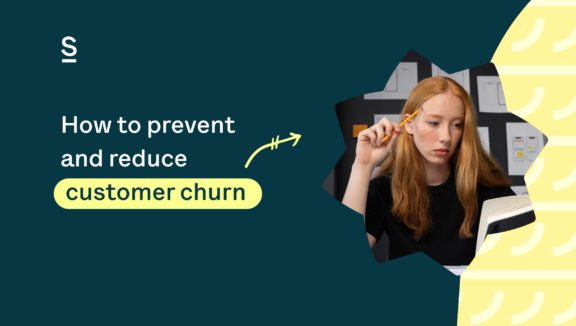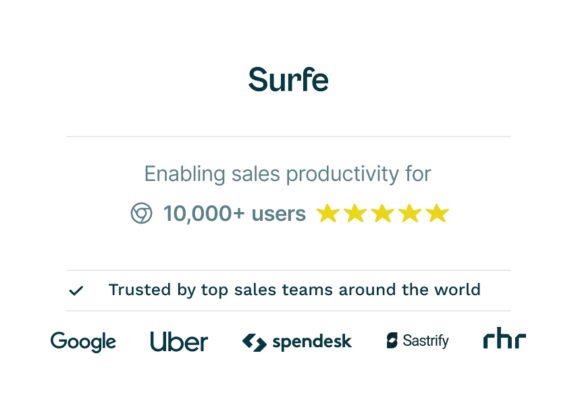How to reduce customer churn – or prevent it from happening in the first place

Got a quiz for you. What’s the word for:
- A big machine used to make butter
- What your stomach does after too many beers
- The number of customers that stop using your business over a period of time
You’ve got it: churn. And while we’d love to chat about butter and beers (both fun and delicious), today we’re running through customer churn, and how to reduce it (less fun and less delicious).
The thing is, while customer churn is not the most comfortable topic for any proud business owner, it’s not something that can be avoided. No business has 0 churn – but that’s certainly the number you should strive for. The more successfully you’re able to prevent and reduce churn, the more your business will grow and the more profitable it will be.
Let’s get into it. Today we’re going to cover:
Understanding customer churn
Simply put, when a customer of yours churns they stop being a customer.
It’s important to keep careful track of your customer churn rate (which you might also know as attrition): it’s a reliable indicator of your business performance, how good your product actually is, how well your team is doing, and more.
Calculating your customer churn rate is pretty simple (though you can still use a calculator if maths isn’t your thing – this is a judgement-free zone).
Your customer churn rate is the percentage of your customer base who cancel or don’t renew their contracts during a set time period – this could be a month, a quarter or a year depending on your business and how long your contracts are.
To figure out your churn rate, divide the number of lost customers by your total customers at the start of the set time period. Next, multiply it by 100.
For example, if you start the year with 100 clients and finish it with 95, your customer churn rate is 5%.
By the way, 5% is generally considered a good churn rate.
The impact of a high churn rate
This one’s easy enough to understand: customers are (usually) far cheaper to retain than they are to acquire. If you’re constantly having to find new customers to hit your targets, as your current ones keep churning, then your customer acquisition costs (CAC) will be higher. This will eat into your revenue – and therefore your profits.
It also impacts your customer lifetime value (LTV) metrics and reduces your market share; both of which are key indicators of a successful business with the scope to grow.
Key metrics and terms to get a handle on
We’ll be discussing two key terms in this blog post: customer retention, and Net Promoter Score (NPS).
Customer retention rate: your customer retention rate tells you the percentage of customers you’re keeping hold of (as you can see, it goes hand-in-hand with your churn rate).
Net Promoter Score: this metric is used to gauge your customer’s experience. Businesses send out a single-question survey to customers to measure their loyalty, and report on the results with the numbers -100 to +100 (the higher the better).
Analyzing customer behavior
What do you do every time a customer leaves? Sit down, have a little cry, and then dust yourself off and move on with your day?
If you answered yes to the above: you’re wrong. Sorry for the tough love.
This shouldn’t have been a surprise: if you keep careful track of customer data (our favourite thing 🤓) you should be aware not everything’s rosy. Plus, you should be digging even deeper post-churn to make sure you have a full understanding of what went wrong.
Let’s take a quick look at some of the metrics you’ll keep track of.
Customer engagement: existing customer suddenly gone quiet? Ignoring all your emails about product updates and the next QBR? Alarm bells should be ringing. On the other hand, if you’ve got a customer that advocates for your business and is interested in everything you tell them you can take that as a positive sign.
Product usage: same as above – if your client stops using your product, they’re probably not going to want to pay for it again when renewal times come around. On the other hand, high product usage scores (particularly if your product is a nice-to-have, not a necessity) indicate high customer satisfaction.
NPS score: track your current score vs the scores that came before to see whether things are on the up, or down.
Historic data: have any previous customers churned? If so, take a long hard look at what went wrong. Can you draw any similarities? What did their engagement and usage metrics look like just before the worst happened? Were you getting negative qualitative feedback, or did something go wrong with the product?
For example: if you have a sudden bout of churning customers (yes, we made it sound like an illness on purpose) you might want to do a little digging. If you find that all the churned customers are attributed to a certain campaign or sales strategy, that would be a good indicator that it’s attracting the wrong type of business.
Some good news: there are plenty of products out there to help you. Just a few include Churnly, Vitally and Churnfree.
Improving customer retention
So, how can we prevent customer churn from happening in the first place? We’d recommend focussing on the following areas:
- Customer support: unless your product is literally perfect (spoiler alert: it’s not) you’ll need a great customer support team to jump in and sort things out when something goes wrong or your client gets stuck.
- Not overpromising: honestly, we don’t think we need to go into the cliche of Sales or Customer success teams over-promising and under-delivering. You should know by now that doing this is only going to come back to haunt you.
- Personalisation and targeted communication: people like to feel special. Send them communications built just for them (or at least, just for their customer segment) to show you really understand them, and want them to get the best out of your partnership.
- Effective loyalty programmes: loyalty programmes can look pretty different in the B2B and B2B SAAS space. Two examples are offering discounted pricing for a longer fixed-term contract, or giving access to exclusive events like round table webinars or networking dinners.
Effective onboarding processes
Onboarding and churn may seem like near opposites (the birth and death of a customer journey, if you will), but good onboarding is actually a crucial factor in churn prevention.
Customers are actually pretty likely to churn in their first few months: a badly managed onboarding process can leave the customers feeling lost and alone, confused about your product and unsure about the value it delivers.
This situation is different from a churn after, say, a couple of years. Common reasons here include a series of mismanaged problems, or your customer receiving a better offer from a competitor, for example.
Onboarding is not just the responsibility of the Sales and Customer Success teams – although they are the first port of call. The Account Executive who made the sale should manage a smooth transition to the Customer Success team, and check in during the first couple of months.
Meanwhile, the Customer Success team should focus on getting to know the customer, understanding their pain points and making sure they’re doing everything they can to alleviate them. A seamless onboarding process includes:
- The use of unique content and interactive elements
- Defined expectations
- Success metrics set, and milestones marked
- Regular check-ins
Meanwhile, Product teams should be working on making the product sticky – and reaching out continuously for feedback to inform their roadmap.
Leveraging customer feedback
The customer feedback loop involves asking customers for feedback on the product, and then actioning their requests. Once the product has been changed according to the feedback, the loop closes. Job done! Methods for collecting customer feedback include:
- Surveys
- CS team meetings
- QBRs
- NPS score
- Feedback portals
- Interviews
- Support Chatbots
- Social media
Deliver this to the Product team in the best way that suits your business. You may want them to join customer interviews or help define what survey questions should be in the first place.
To take a really basic example, your Customer Support team might pick up that a particular problem with the product’s functionality is being referenced over and over again in their messaging with current customers. They deliver this to the Product team, who realise they have something to fix or improve. Easy peasy.
Utilizing Net Promoter Score (NPS)
NPS is a benchmarking tool used by businesses to see how satisfied their customers are. In a nutshell, a one-question survey is sent out – usually asking a question like ‘How likely are you, on a scale of 0-10 to recommend our business to a contact?’.
Anyone who gives a 0-6 (boo) is a detractor, a 7-8 is a passive, and a 9-10 is a promoter. Notice that you have to get the two highest numbers to do properly well here – there’s just no room for mediocrity.
This gives insights into customer loyalty and how close (or far) they are to becoming a product advocate.
If you get a low NPS score, there are several actions you can take. If you don’t have that many customers, and you know who left the negative scores you can address it directly. This is a great chance to practise your active listening and problem-solving skills (always a silver lining, eh).
If you’re getting more negative NPS scores than not, you may want to take action on a larger scale. This could mean reaching out to everyone acknowledging the problem, and detailing what actions you are going to take to fix it.
Proactive customer service
Ok, so you know how to nail onboarding, what metrics to keep an eye on and how to gather all the customer feedback you could ever want. Next, we’re going to talk about the role of proactive customer service.
Proactive customer service is anticipating needs and problems well in advance – and going right ahead to help. We’re sure we don’t need to tell you that it’s the opposite of reactive customer service: waiting to be told about needs and problems.
Examples of proactive support include: noticing that usage rates are low and asking if customers are struggling with the product or reaching out if there’s been an error and letting customers know.
But how do you find out what these needs and problems might be in the first place? We’ve got you:
- Surveys
- Knowledge base
- Products you may like
- Email newsletter
- Automated scheduling services
Continuous improvement and innovation
Here’s the thing: once you’ve got your customer attrition rates down and are confident there aren’t any problems on the horizon, you can’t just relax and forget about it.
You need to continuously persuade your customers that your product is the best – otherwise, they could still jump ship from your perfectly decent service to a shiny new competitor.
Positive innovation is always a good thing and the more differentiated offerings you have, the more likely you are to come out on top. You might want to try:
- New prices
- More comprehensive customer service
- Better value
- New product features
Just don’t do it all at once – that’s not going to help anybody – and make sure these new implementations are based on customer needs or what your competitors are doing rather than the whims of your team.
Let’s wrap it up!
Reducing customer churn: sounds scary, but focus on doing the basics really well and you’ll pretty much have it down. The most important principle of all? Listen to your customers, and look for signs of their happiness (hopefully) or unhappiness (hopefully not).
You’ll be a churn master before you know it.

The secret to modern-day B2B success
is *ssssh* Surfe. It hunts down contact data, keeps your CRM clean and manages communications in LinkedIn – and trying it is free!
Don’t tell anyone we told you.
FAQs about reducing customer churn
How to save a customer from churning?
You should always be keeping an eye on qualitative feedback from your customers and quantitative metrics like engagement rate and product use. If either of these metrics seem low, or you’re getting regular negative feedback from a customer, it’s important to sit down with them, listen carefully to their problems and draw up an action plan to get the relationship back on track. The more proactive you can be about preventing customer churn, the lower your churn rate will be.
What strategies can be implemented to reduce customer churn?
Retention strategies you can take to reduce customer churn include:
- Analysing customer behaviour: using metrics like engagement rate and product usage
- Providing proactive customer support, as well as reactive customer support
- Not overpromising what you can deliver
- Sending personalised and targeted communication – this could be having a dedicated slack channel, or segmenting your customers for pain-point-based email campaigns
- Running impactful loyalty programmes that make a difference for your customers
What is the meaning of customer churn?
If a customer churns, they stop being a customer of your business. They will stop using your product and end your contract. Customer churn is measured by a customer churn rate, and often occurs either during the onboarding process or after a series of problems that have not been resolved satisfactorily.
What is a customer churn rate?
Your customer churn rate is how many customers have left your business over a set period of time: it could be measured over a month, a quarter or a year, for example. You calculate your churn rate by dividing the number of lost customers by your total customers at the start of the set time period, and then multiplying this number by 100.
What is a good customer churn rate?
A good rule of thumb is to try and keep your customer churn rate at about 5%. Note that it’s impossible to have a 0% churn rate – although that is certainly the metric you should be aiming for!


